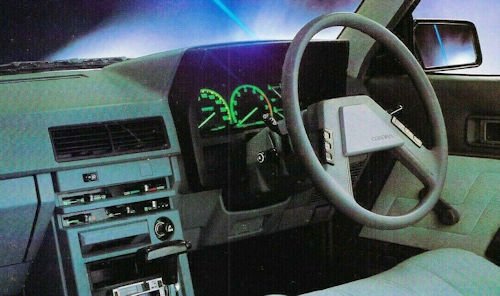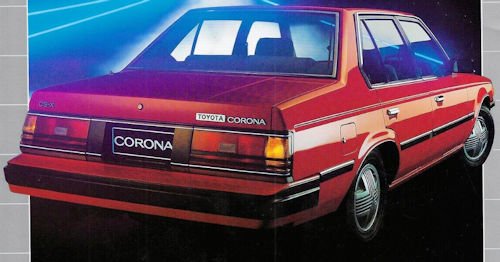Toyota Corona 7th generation
 |
|
|
Model code |
T140 |
|
Production |
1982 to 1998 (Taxi) |
|
Body style |
|
|
Layout |
Front-engine, rear-wheel-drive |
|
Engine |
|
|
Transmission |
|
|
Wheelbase |
2,500 mm (98.4 in) |
|
Length |
4,495–4,570 mm (177.0–179.9 in) |
|
Width |
1,660 mm (65.4 in) |
|
Height |
1,315–1,415 mm (51.8–55.7 in) |
|
Curb weight |
965–1,165 kg (2,127–2,568 lb) |
The seventh generation of the Corona was introduced in January 1982. But a year later, the Corona model series split into two camps.
In October, the model series was added to the sports model Corona 2000GT , which now has an 18R-GEU with about 1800 cc. However, most of the foreign markets used the 3,000 GTEU with 118 kW (160 hp) for the 2000 GT , as the 18R GEU did not comply with the regulations there.
The taxi model with its own generation name CT141 was initially available only with diesel engines. A liquefied gas version came in December 1982 in the trade. The Toyota Corona could be equipped with the system Back Sonar , making it the first car with an ultrasonic- based parking aid.
1982 -Full model change. It transformed into an angular "advanced wedge" style, emphasizing a stylish image to compete with the 6th generation Bluebird (910 series). Also , from this generation the platform was shared with Carina Celica . In particular, the hardtop is based on the 60-series Celica, which has a lower vehicle height (centre of gravity) than the conventional sedan-based car, and has a sporty design that breaks away from the conventional image of the Corona. The fastback style 5-door sedan disappeared once, but one year later it will be revived again with the T150 series, which will be the first FF layout in the history of Corona. For owners, the T140 series, which had an unusually short life cycle among the successive Coronas, had an irregular model life from a sports model exclusive car to a taxi and other business use. And this was the last rear-wheel drive Corona.

October 1982 - 1800GT-T/GT-TR equipped with a 1.8L twin cam turbo 3T-GTEU engine was introduced in place of the previous 2000GT (equipped with an 18R-GEU engine).
Toyota brought in October 1983 for the remaining Corona models new engines. So got the 12T-J and the 5K-J entry into the engine selection. These models were mostly sold on the domestic and Australian market. For the remaining markets remained mostly the older engines. The 1600GT meanwhile got the 4A-GEU as standard . The new Corona GT-R versions, however, were also equipped with a sports package. The interior was completely redesigned, so that the new top models stood out from the rest of the model variants.
October 1983 - In response to the introduction of the front-wheel drive T150 series 4-door sedan, the sedan received a model reorganization in less than two years, and the low-priced grade (1500STD, 1500DX, 1500GX/1800GX) and sports specification GT Only the system was left. At the same time, a minor change was made to the 1600GT equipped with a 4A-GEU engine, and special 15-inch tires/aluminium wheels, wheel arch mouldings, mudguards, power steering, sports seats, "TWINCAM16" tape stripes, (hardtop only rear wiper), etc. The equipped 1600GT "Sports 7 specification" will appear. In addition, the van's gasoline engine was changed from 1.6L 12T-J to 1.5L 5K-J.
August 1985 - The 2-door hardtop was abolished due to the release of the successor model, the front- wheel drive Corona Coupe . At the same time, with the addition of the GT and GT-R equipped with the 3S-GELU engine to the front-wheel drive sedan, the rear-wheel drive GT series was discontinued. Only 1800GX with 1.8L 1S-U engine and 1500STD/DX/GX with 3A-U engine were sorted out.
December 1987 -With the start of sales of the 9th generation (T170 series) Corona, which will be described later, sales of T140 series sedans and vans for private use will end.
Taxi specification
January 1982 - Taxi specification diesel car appeared. Equipped with 1.8L, 1C type engine. The rear suspension adopts the same 4-link type as for private use, and the braking system uses all-wheel (4-wheel) drum brakes as before. (LPG cars continue to sell the predecessor 130 series)
September 1982 - Taxi specification LPG car appeared. 1.8L, LPG specification with 2Y-PU type engine added. Unlike the diesel vehicle, the rear suspension uses a traditional leaf spring.
On August 2, 1985, Toyota abolished the hardtop model and replaced it by extending the GT-R series. After a hitherto sluggish sale of the GT-R models, Toyota changed the rear lights, grille and the front end, which made the model look sportier.
In December 1986, the Toyota Motor Corporation changed the taxi (CT141). Changes were made to the door panels and the front end. An innovation in the program was now also the Corona Taxi A60 with a gasoline engine (Super). Compared to the diesel and LPG versions, the new A60 was cut by 140 mm. The C-pillar, however, was moved 40 mm to the rear, so that the passenger had a larger footwell. Also, with the diesel variant there was a change. This received the newly developed 1C-2C engine. The combination variant got the somewhat stronger 1C engine.
December 1986 -In response to a major specification change (minor change), a taxi-only car appeared. All outer panels other than the trunk panel have been changed, and the front grille, lights, and turn signals are diverted from those of the A60 Carina Van (the Super DX specification car is the A60 Carina Coupe/Surf-plated one), and other front and rear. The bumper, front balance panel, hood lock brace, and other parts of the A60 Carina sedan were partially used to shorten the overall length by 140mm. received. At the same time, the diesel engine was changed from the 1.8L 1C type to the 2.0L 2C type. It was exported not only to Japan but also to Hong Kong , Macao , Singapore , etc.
November 1991 - Abolition of 2.0L diesel vehicles, lineup of all vehicles LPG specification only. July 1992 - Improvements centred on strengthening safety equipment. All models are equipped with side door beams, rear 3-point seat belts (2-point seat belts for the centre seat), front wheel disc brakes, and footrests. Optional high mount stop lamp. The AM radio was changed to an electronic tuner type.1998 September - Sales ended in a form integrated with Comfort , which started selling in December 1995 (at that time) .
A year later, the production of the taxi model was discontinued in December. In November 1991 also the Diesel. Only the sedan was still in production until 1998. In Australia and New Zealand, the model generation was abandoned in 1987.

